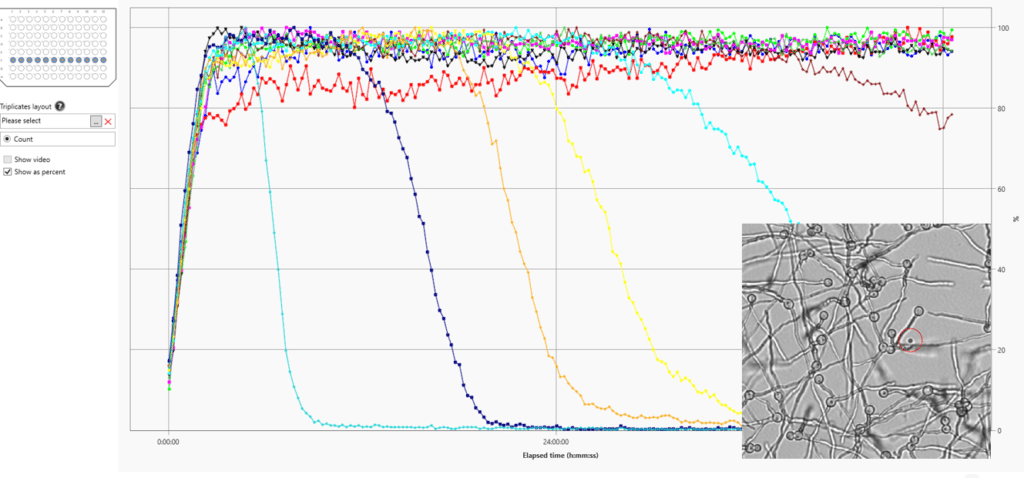Sustainable agriculture and pest control
Insects are a pest in agriculture and cause significant losses in crop yields and storage. A global need for new and efficient alternatives to chemical pesticides is driving the discovery of new bio pesticides. The oCelloScope is used by many agriculture companies in different BioAg applications.

SporeCount
SporeCount
Bio control agents such as Metharizium, Trichoderma, Coniothyrium, Isaria and Purpureocillium can be counted and quantified using the SporeCount function developed by BioSense Solutions. The SporeCount module is based on machine learning and is developed to count small round spores, normal sized spores or elongated spores. The algorithm can be used for final product enumeration or viability studies. SporeCount is able to count spores in many “dirty” samples or samples with hyphae. Counts can be performed in solution in microtiter plates or on agar. Mini agar disks (Cat No. USC.69.0013) have been developed by BioSense solutions to image in 12-well plates and significantly save on consumables.
Easy and fast agricultural counts
Quantify germination in few easy steps
Prepare and pipette your samples into microtiter wells. Set your desired time intervals in the UniExplorer software and choose which algorithms to use. The results can be displayed in the software and exported to excel.
A unique feature is to view results as percent. To the right 8 wells are analyzed. Algorithm count non-germinated spores and precise time of germination and proportion germinated in percent can easily be established.
Engineered microbes and improved yields
The Rhizomicrobiome is contributing to yield and productivity in different ways. Microorganisms can improve soil fertility, texture, nutrient acquisition, and secretion of intra and extracellular molecules and metabolites. The oCelloScope is used to optimize growth of engineered strains, determine morphology adaptations and to look at interactions using a non-invasive technology.
To the right you see a sample from an infested garlic. There are several fungal species in sample. In focus you see Fusarium, a plant pathogen responsible for significant yield losses in crops.
Tracking of individual cells
In BioAG R&D knowing how spores develop from dormant to isotropic growth has historically been a “black box”. With the new tracking module in UniExplorer you can now track each spore in a population over time. You get to see and quantify development using an array of different parameters. In addition, we present your data in histograms for particle size distribution.
Tip! When making deeper analysis we recommend to load an existing job to run the analysis on. Being able to see the images when you program your settings greatly improves results. Remember that you are always free to re-analyze any job with any algorithm.
Testing new antifungals in BioAg
Teams around the world are developing new and green biopesticides to replace the extensive use of chemicals. With the oCelloScope you can test both species and new substances on pathogenic species. You get analysis and images to support your research. On the right you see a fungal pathogen treated with different concentrations of compound X. Initial increase in curve is settling of spores on the bottom of plates. Dropping of curve means germination of spores and experiment shows effectiveness of compound at different concentrations.
Tip! If you need a special algorithm for species detection please reach out to our custom development team.

Bacillus viability and growth kinetics
In BioAg, multiple commercial products contain Bacillus species. On the left we test the viability of a commercial product containing Bacillus subtilis and Bacillus paralicheniformis. Product is supplied as spore suspension. Experiment is carried out in 96-well plate and spores are initially seen as small dots. After a few hours in liquid medium, spores enter vegetative growth and growth is measured. Spores can also be grown on agar using our mini agar disks and colony tracking module. Below is a zoom of three times points. Speed of growth varies between spores.

Machine Learning Mycelium Tracker
Fusarium is a widely used plant pathogen in Agriculture R&D. BioSense Solutions have developed deep learning algorithms to accurately segment mycelium and quantify crossings/branchpoints. In image we find mycelium in blue and crossing/branching in green. Many features are to be quantified such as tip points, area, length etc. Algorithm is used on specific Z-layer and can give better insights to the mechanisms of your antifungal.


Mycelium Tracker
The new Mycelium Tracker module is in development and will be a one-of-a-kind tool for fungal researchers. We are able to find and track fungal growth over time until too much overlapping takes place. If you cannot see – you cannot quantify morphology.
On the left is a comparison of 2 Aspergillus fumigatus samples

Fast CFU/ml Assay
BioAg fermentation often get contaminated by unwanted bacteria. With the IntuGrow assay you get to determine CFU/ml in hours instead of days. Use your selective agar with our mini agar disks and our dedicated software will count bacterial growth over time. Method has been validated against EU GMP method and is in routine use at pharmaceutical production sites.


